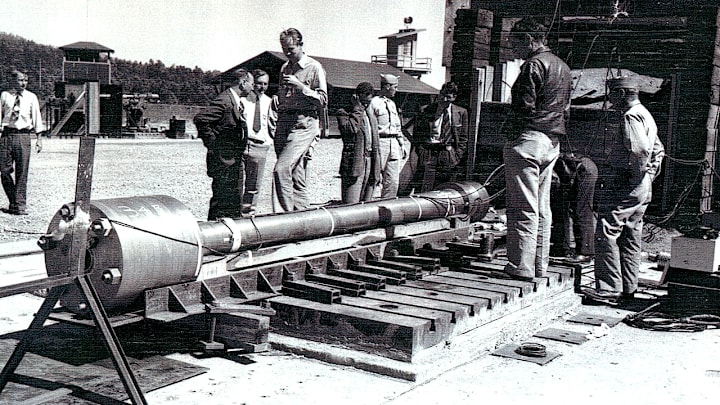Two atomic bombs nicknamed Little Boy and Fat Man were detonated over Hiroshima and Nagasaki in August 1945, effectively ending World War II. The U.S. had rushed headlong into the development of the bombs, trying to develop the unprecedented nuclear weapons before the Nazis did, and succeeded.
Manhattan Project scientists built at least four bombs—Little Boy, Fat Man. the Gadget, and Thin Man. The first three made it to fruition, and the first two became the only atomic bombs ever deployed in war. Thin Man never saw the light of day.
How to the Atomic Bombs Were Built
There are two different ways to build an atomic bomb. One is gun-type assembly, in which a hollow, sub-critical (less mass than needed to sustain a chain reaction) fissile “bullet” is shot at a solid supercritical (able to sustain a chain reaction) core. The bullet strikes and compresses the core, fission happens, and the bomb explodes. This type of assembly is relatively simple in design, involving one thing being shot at another.
The second type of assembly is a bit more complex. Implosion-type assembly involves a hollow sphere containing an intricate arrangement of high explosives and detonators, surrounding a solid fissile, but not yet supercritical, core. The high explosives are detonated in such a way that the blast wave compresses the core to a supercritical density. This causes fission, which makes the bomb explode.
Thin Man was a gun-type weapon designed to use plutonium as fuel. But scientists found that the reactor-produced plutonium available at the time contained too many impurities, causing a greatly increased spontaneous fission rate—meaning that the fuel would pre-detonate and blow itself apart while trying to attain criticality, rather than after. It would be putting the nuclear cart before the horse. So the bomb was scrapped, and focus turned to Little Boy.
You May Also Like:
- 6 Misconceptions About the Cold War
- 7 Close Calls in the Nuclear Age
- Why Do We Still See Fallout Shelter Signs?
Shadow of Thin Man
Little Boy was the same type of weapon as Thin Man—except for the fact that it used uranium rather than plutonium. Since uranium isn’t as prone to pre-detonation, a much simpler weapon was designed, without many of the safeguards of the Thin Man design.
Even though plutonium wasn’t a good choice for gun-type weapons, it worked well in the implosion design, which included more safety features that prevented pre-detonation of the plutonium. While Thin Man and Little Boy were being developed, the scientists were also working on The Gadget and Fat Man, which were both implosion-type devices, using plutonium (and uranium) as fuel.
Since the implosion design was more complex, it was tested before being put into action. The Gadget was detonated in the New Mexico desert during the Trinity Test on July 16, 1945. The test was successful and became the first human-made nuclear explosion in history. U.S. officials were now relatively certain that Fat Man would work as expected because it used the same design.
After Thin Man
Pieces for Little Boy were sent to the Mariana Islands for final assembly two hours before the Trinity Test. But Little Boy was never actually tested before detonation.
The gun-type assembly was thought to be simple enough that it would detonate without problem. And enriched uranium was much harder to come by than plutonium, so officials didn’t want to waste the rare stuff on a test. Time was also a factor: It had taken years to enrich enough uranium to use in this one bomb. The U.S. simply didn’t want to wait the months or years necessary to accumulate enough uranium for another bomb.
Little Boy was successfully detonated over Hiroshima on August 6, 1945, and Fat Man was unleashed on Nagasaki three days later. The world’s horror at their destructive power largely prevented further use of nuclear weapons, including Thin Man, the bomb that never was.
A version of this story was published in 2013; it has been updated for 2025.
